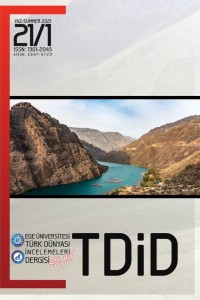Abstract
Çevremize ait bilgiler, istemli veya istemsiz olarak kazandığımız tecrübeler, yaşanmışlıklar hayata gözümüzü açmamızdan itibaren duyularımız vasıtasıyla beyne iletilir ve beyin tarafından örgütlenerek anlamlı hale getirilir. İnsan zihni, çevresini algılayıp dile aktarırken çok yönlü olarak işler ve karmaşık ilişkiler kurar. Nesneler ve durumlar arasında ilişkiler kurarken aktarmaları kullanır; böylece dil gelişir ve işlevsellik kazanır.
Algı fiillerinin çok anlamlılığına muhtelif dillerde sıkça rastlanmaktadır. Bu salt dilin yapısıyla alakalı bir durum değildir; bir kavramı başka bir kavrama göre anlamaya çalışmak insanın düşünce yapısı ve dil edinimiyle yakından ilgilidir. Kavramsal metaforların sistematiği bize bir terimin bir yönünü diğer bir kavrama göre anlamlandırma imkânı verebilir. İşte Kutadgu Bilig’de de bazı olumlu-olumsuz duygu ve durumların yemek kavramına göre yapılandırıldığı anlaşılmaktadır. YE- algı fiili, edebî/literal “yeme” anlamının dışında özellikle “kavuşmak, elde etmek, elinde tutmak, kazanmak”, “hissetmek, maruz kalmak”, “tüketmek, yok etmek”, “kubul etmek” gibi çok anlamlı bir görünüme sahiptir.
Bu çalışmada bilişsel dil bilim incelemelerinde ön plana çıkan kavramsal metafor kuramına göre Kutadgu Bilig’deki tatma duyumuzla ilgili YE- fiilinin diğer kavramlarla olan metaforik ilişkileri incelenecektir.
References
- Aksan, D. (2009). Anlambilim, Anlambilim Konuları ve Türkçenin Anlambilimi. Ankara: Engin.
- Arat, R. R. (2008). Kutadgu Bilig Yusuf Has Hacib. İstanbul: Kabalcı.
- CHOMSKY, N. (2001). Dil ve Zihin. Ahmet Kocaman (Çev.). Ankara: Ayraç.
- Clifford, T. M. (2011). Psikolojiye Giriş. Sirel Karakaş V. S. (Çev.). Konya: Eğitim Akademi.
- Çetinkaya, B. (2006). Türkiye Türkçesinde Mutluluk ve Üzüntü Göstergeleri. (Yayımlanmamış Doktora Tezi) Gazi Üniversitesi/ Sosyal Bilimler Enstitüsü, Ankara.
- Çetinkaya, B. (2017). Kutadgu Bilig’de Kavramsal Metaforlar. Afyon Kocatepe Üniversitesi Sosyal Bilimler Dergisi, 19 (2). Doi: 02377810061849. 377-399.
- Gökçe, F. (2015). Kutadgu Bilig’de Kör- “Görmek”: Çok Anlamlılık, Metafor ve Gramerleşme. Türkbilig, 29, 59-76.
- Kaçalin, M. S. (n.d.). Kutadğu Bilig Metin. Kültür ve Turizm Bakanlığı 420. https://ekitap.ktb.gov.tr/Eklenti/10716,yusufhashacibkutadgubiligmustafakacalinpdf.pdf?0
- Kamchybekova, K. (2010). Kırgız Türkçesinde Duyu Fiilleri. (Yayımlanmamış Doktora Tezi). Ankara Üniversitesi/ Sosyal Bilimler Enstitüsü, Ankara.
- Kövecses, Z. (2005). Metaphor in Culture. Cambridge: Cambridge University.
- Lakoff, G. ve Johnson, M. (2015). Metaforlar Hayat, Anlam ve Dil. Gökhan Yavuz Demir (Çev.). İstanbul İthaki.
- Şerifoğlu, Y. (2012). Dil-Zihin İlişkisi Çerçevesinde Metaforlar. AİBÜ Sosyal Bilimler Enstitüsü Dergisi, 12 (2), 123-131.
- YAYLAGÜL Ö. (2005). Türk Runik Harfli Metinlerde Mental Fiiller. Modern Türklük Araştırmaları Dergisi, 2 (1), 17-51.
- Yunusoğlu, M.K. (2020). Budist Türk Çevresi Eserlerde Metaforlar. Ankara: Türk Dil Kurumu 1175.
Abstract
The information about our environment, the experiences we have gained voluntarily or involuntarily, the experiences are transmitted to the brain through our senses since we open our eyes to life and they are organized and made meaningful by the brain. The human mind works in a versatile way and establishes complex relationships while perceiving its environment and translating it into language. The human mind uses transfers in establishing relationships between objects and situations; Thus, the language develops and becomes functional.
The polysemy of perception verbs is frequently encountered in various languages. This is not just about the structure of language; trying to understand one concept according to another concept is closely related to human mindset and language acquisition. The systematic of conceptual metaphors can give us the opportunity to make sense of one aspect of a term according to another concept. It is understood that in Kutadgu Bilig, some positive and negative emotions and situations are structured according to the concept of food. YE- perception verb, apart from the literal meaning of "eating", has a polysemic appearance such as "to meet, to obtain, to hold, to win", "to feel, to be exposed", "to consume, to destroy", "to adopt".
In this study, the metaphorical relations of the verb YE-related to our sense of taste in Kutadgu Bilig with other concepts will be examined according to the conceptual metaphor theory that comes to the fore in cognitive linguistics studies.
References
- Aksan, D. (2009). Anlambilim, Anlambilim Konuları ve Türkçenin Anlambilimi. Ankara: Engin.
- Arat, R. R. (2008). Kutadgu Bilig Yusuf Has Hacib. İstanbul: Kabalcı.
- CHOMSKY, N. (2001). Dil ve Zihin. Ahmet Kocaman (Çev.). Ankara: Ayraç.
- Clifford, T. M. (2011). Psikolojiye Giriş. Sirel Karakaş V. S. (Çev.). Konya: Eğitim Akademi.
- Çetinkaya, B. (2006). Türkiye Türkçesinde Mutluluk ve Üzüntü Göstergeleri. (Yayımlanmamış Doktora Tezi) Gazi Üniversitesi/ Sosyal Bilimler Enstitüsü, Ankara.
- Çetinkaya, B. (2017). Kutadgu Bilig’de Kavramsal Metaforlar. Afyon Kocatepe Üniversitesi Sosyal Bilimler Dergisi, 19 (2). Doi: 02377810061849. 377-399.
- Gökçe, F. (2015). Kutadgu Bilig’de Kör- “Görmek”: Çok Anlamlılık, Metafor ve Gramerleşme. Türkbilig, 29, 59-76.
- Kaçalin, M. S. (n.d.). Kutadğu Bilig Metin. Kültür ve Turizm Bakanlığı 420. https://ekitap.ktb.gov.tr/Eklenti/10716,yusufhashacibkutadgubiligmustafakacalinpdf.pdf?0
- Kamchybekova, K. (2010). Kırgız Türkçesinde Duyu Fiilleri. (Yayımlanmamış Doktora Tezi). Ankara Üniversitesi/ Sosyal Bilimler Enstitüsü, Ankara.
- Kövecses, Z. (2005). Metaphor in Culture. Cambridge: Cambridge University.
- Lakoff, G. ve Johnson, M. (2015). Metaforlar Hayat, Anlam ve Dil. Gökhan Yavuz Demir (Çev.). İstanbul İthaki.
- Şerifoğlu, Y. (2012). Dil-Zihin İlişkisi Çerçevesinde Metaforlar. AİBÜ Sosyal Bilimler Enstitüsü Dergisi, 12 (2), 123-131.
- YAYLAGÜL Ö. (2005). Türk Runik Harfli Metinlerde Mental Fiiller. Modern Türklük Araştırmaları Dergisi, 2 (1), 17-51.
- Yunusoğlu, M.K. (2020). Budist Türk Çevresi Eserlerde Metaforlar. Ankara: Türk Dil Kurumu 1175.
Details
| Primary Language | Turkish |
|---|---|
| Subjects | Language Studies |
| Journal Section | Research Article |
| Authors | |
| Publication Date | June 18, 2021 |
| Published in Issue | Year 2021 Volume: 21 Issue: 1 |
 Journal of Turkish World Studies is licensed under a Attribution-NonCommercial 4.0 International license.
Journal of Turkish World Studies is licensed under a Attribution-NonCommercial 4.0 International license.


